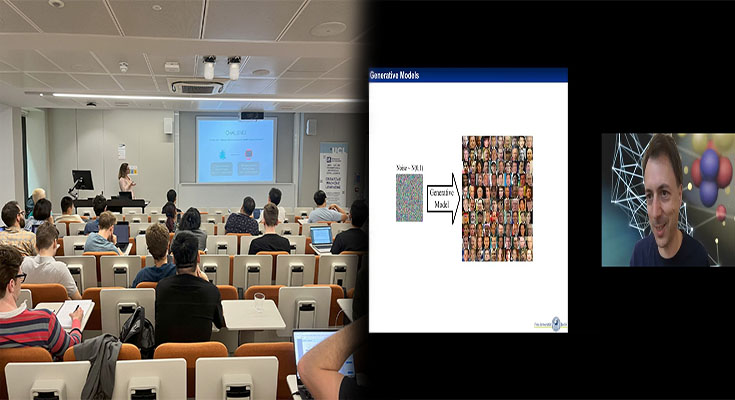Machine learning is a branch of artificial intelligence (AI) that gives computers the ability to learn without being explicitly programmed. Machine learning can be used in a wide range of applications, like: computer vision, speech recognition, natural language processing and many others. In this post we provide an overview of machine learning lectures online in order to help you get started with ML or enhance your knowledge if you are already using it.
Machine Learning Video Lectures
The Machine Learning Video Lectures archive contains 10 lectures on the topic of machine learning. The course is available for free on YouTube, but also has a page on Coursera’s website where you can access additional resources and quizzes.
The course is recommended for beginners who have an interest in learning more about how computers learn from data.
Overview of Lectures
This course is about machine learning. It will cover the following topics:
- The basics of probability and statistics, including distributions and hypothesis testing
- Classification algorithms (e.g., decision trees, logistic regression)
- Clustering techniques (k-means clustering)
- Unsupervised learning methods (e.g., principal components analysis, neural networks).
Machine Learning Overview
Machine learning is a subfield of artificial intelligence that focuses on algorithms that can learn from data. Machine learning is about building algorithms that can learn from data, and it’s a very broad term that encompasses many different types of algorithms, including:
- Supervised Learning: When you have both input and output data, machine learning algorithms use this information to make predictions about future examples (for example, predicting which customers are likely to churn).
- Unsupervised Learning: When there isn’t any labeled data available and you just want your algorithm to find patterns in the unstructured data itself (for example, clustering similar items together).
- Reinforcement Learning: This type of algorithm learns by interacting with its environment over time as opposed to being given labeled examples ahead-of-time like supervised or unsupervised methods do; this technique has been used successfully in games such as Atari 2600s Breakout game where we want our agent (the player) to maximize points while minimizing deaths!
Statistical Learning Algorithms
Statistical learning algorithms are a subset of machine learning algorithms. They’re used to make predictions from data, where the goal is to learn some generalizable relationship between inputs and outputs based on observations in the training set.
Statistical learning algorithms can be used for regression problems (predicting real-valued quantities), classification problems (predicting discrete values), or clustering problems (grouping similar items together).
Linear Regression
Linear regression is a supervised learning algorithm that creates a model to predict future values of a dependent variable based on past values of the dependent variable.
The algorithm uses a linear function to model the relationship between an independent variable (x) and dependent variable (y). The slope of this line represents how much y changes when x changes by 1 unit. The intercept term represents where y would be if x were 0.
Logistic Regression
Logistic regression is a statistical technique used to predict the probability of an event belonging to one of two categories. It’s often used in machine learning and data science applications that involve predicting whether or not something will happen.
Let’s say you want to predict which customers will respond positively when receiving an email campaign from your company, based on their past behavior and other variables such as age and gender. The dependent variable (y) would be 1 if they did respond positively, and 0 otherwise (i.e., no). In this case, we could create our training dataset by taking customer information like age, gender etc., along with whether or not they responded positively after receiving an email campaign from us – making sure each row has both values! Then we could use logistic regression models trained on these examples so that when new data comes in we can predict how likely it is that someone will respond positively based on their age/gender etc..
Naive Bayes Classifier and Other Probabilistic Models
Probabilistic models are a type of machine learning model that uses probability theory to make predictions. Naive Bayes is one example of a probabilistic model, but there are many others: logistic regression, k-nearest neighbors and decision trees are all examples of probabilistic models.
The basic idea behind these models is that they’re able to make predictions by calculating the probability that something will happen based on known probabilities between different variables (for example, how likely it is for two people to be friends if they share interests).
Neural Networks and Deep Learning
Neural networks can be used for regression, classification and clustering. Deep learning is a subset of neural networks that uses multiple layers of non-linear processing units (neurons).
Deep learning has seen rapid growth in recent years due to its ability to solve complex problems like computer vision, speech recognition and natural language processing (NLP).
Support Vector Machines and Kernel Methods
Support vector machines (SVMs) are a class of supervised learning algorithms that can be used for classification and regression. They’re called “support vector machines” because they find a hyperplane to separate the given dataset into two classes using the maximum margin criterion.
Kernel methods are computational techniques used in statistical pattern recognition and machine learning, which rely on kernels– functions that map data from its original space into other spaces where it can be analyzed more easily. These methods include support vector machines (SVMs), Gaussian mixture models (GMM), kernel principal component analysis (kPCA) and nonnegative matrix factorization (NMF).
These lectures provide an overview of machine learning, types of machine learning models, applications of machine learning and resources to learn more.
This video series provides an overview of machine learning, types of machine learning models, applications of machine learning and resources to learn more.
If you have any questions, please feel free to contact us.





